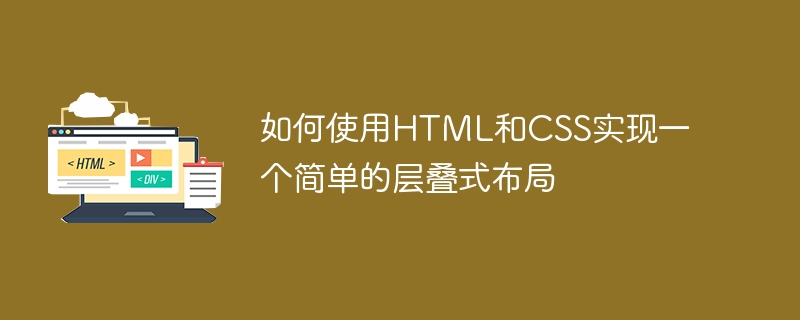How to implement a simple cascading layout using HTML and CSS

How to use HTML and CSS to implement a simple cascading layout
Cascading layout is a common layout method in front-end development, which can implement multiple elements The cascading arrangement adds beauty and interactive effects to the web page. In this article, we will introduce how to implement a simple cascading layout using HTML and CSS, and provide specific code examples.
First, we create an HTML file and add the following code:
<!DOCTYPE html>
<html>
<head>
<title>层叠式布局</title>
<link rel="stylesheet" type="text/css" href="style.css">
</head>
<body>
<div class="container">
<div class="box red"></div>
<div class="box green"></div>
<div class="box blue"></div>
</div>
</body>
</html>In the above code, we create a parent container (class "container") containing three child elements. Each child element has a "class of box" and a different color class ("red", "green" and "blue").
Next, we create a CSS file named style.css and add the following code:
.container {
width: 500px;
height: 300px;
}
.box {
width: 200px;
height: 150px;
position: absolute;
}
.red {
background-color: red;
top: 50px;
left: 50px;
}
.green {
background-color: green;
top: 100px;
left: 100px;
}
.blue {
background-color: blue;
top: 150px;
left: 150px;
}In the above code, we set the settings for the parent container (class is "container") width and height. For the child element (class "box"), we set the width and height to fixed values, and set its position attribute to absolute, so that it is separated from the document flow and can be positioned freely.
Then, we set different background colors for different sub-elements respectively, and use the top and left attributes to position them in different positions.
With the above HTML and CSS code, we have completed a simple cascading layout. Open the HTML file in your browser and you will see three overlapping squares in red, green and blue.
Of course, there are many other application scenarios and methods for cascading layout. In actual development, we can control the stacking order of elements by using the z-index attribute, and achieve more complex effects through other CSS properties.
I hope this article will help you understand the basic principles and applications of cascading layout. If you have more questions or need further explanation, please feel free to ask.
The above is the detailed content of How to implement a simple cascading layout using HTML and CSS. For more information, please follow other related articles on the PHP Chinese website!

Hot AI Tools

Undresser.AI Undress
AI-powered app for creating realistic nude photos

AI Clothes Remover
Online AI tool for removing clothes from photos.

Undress AI Tool
Undress images for free

Clothoff.io
AI clothes remover

AI Hentai Generator
Generate AI Hentai for free.

Hot Article

Hot Tools

Notepad++7.3.1
Easy-to-use and free code editor

SublimeText3 Chinese version
Chinese version, very easy to use

Zend Studio 13.0.1
Powerful PHP integrated development environment

Dreamweaver CS6
Visual web development tools

SublimeText3 Mac version
God-level code editing software (SublimeText3)

Hot Topics
 1386
1386
 52
52
 How to use bootstrap in vue
Apr 07, 2025 pm 11:33 PM
How to use bootstrap in vue
Apr 07, 2025 pm 11:33 PM
Using Bootstrap in Vue.js is divided into five steps: Install Bootstrap. Import Bootstrap in main.js. Use the Bootstrap component directly in the template. Optional: Custom style. Optional: Use plug-ins.
 The Roles of HTML, CSS, and JavaScript: Core Responsibilities
Apr 08, 2025 pm 07:05 PM
The Roles of HTML, CSS, and JavaScript: Core Responsibilities
Apr 08, 2025 pm 07:05 PM
HTML defines the web structure, CSS is responsible for style and layout, and JavaScript gives dynamic interaction. The three perform their duties in web development and jointly build a colorful website.
 How to write split lines on bootstrap
Apr 07, 2025 pm 03:12 PM
How to write split lines on bootstrap
Apr 07, 2025 pm 03:12 PM
There are two ways to create a Bootstrap split line: using the tag, which creates a horizontal split line. Use the CSS border property to create custom style split lines.
 Understanding HTML, CSS, and JavaScript: A Beginner's Guide
Apr 12, 2025 am 12:02 AM
Understanding HTML, CSS, and JavaScript: A Beginner's Guide
Apr 12, 2025 am 12:02 AM
WebdevelopmentreliesonHTML,CSS,andJavaScript:1)HTMLstructurescontent,2)CSSstylesit,and3)JavaScriptaddsinteractivity,formingthebasisofmodernwebexperiences.
 How to resize bootstrap
Apr 07, 2025 pm 03:18 PM
How to resize bootstrap
Apr 07, 2025 pm 03:18 PM
To adjust the size of elements in Bootstrap, you can use the dimension class, which includes: adjusting width: .col-, .w-, .mw-adjust height: .h-, .min-h-, .max-h-
 How to set up the framework for bootstrap
Apr 07, 2025 pm 03:27 PM
How to set up the framework for bootstrap
Apr 07, 2025 pm 03:27 PM
To set up the Bootstrap framework, you need to follow these steps: 1. Reference the Bootstrap file via CDN; 2. Download and host the file on your own server; 3. Include the Bootstrap file in HTML; 4. Compile Sass/Less as needed; 5. Import a custom file (optional). Once setup is complete, you can use Bootstrap's grid systems, components, and styles to create responsive websites and applications.
 How to insert pictures on bootstrap
Apr 07, 2025 pm 03:30 PM
How to insert pictures on bootstrap
Apr 07, 2025 pm 03:30 PM
There are several ways to insert images in Bootstrap: insert images directly, using the HTML img tag. With the Bootstrap image component, you can provide responsive images and more styles. Set the image size, use the img-fluid class to make the image adaptable. Set the border, using the img-bordered class. Set the rounded corners and use the img-rounded class. Set the shadow, use the shadow class. Resize and position the image, using CSS style. Using the background image, use the background-image CSS property.
 How to use bootstrap button
Apr 07, 2025 pm 03:09 PM
How to use bootstrap button
Apr 07, 2025 pm 03:09 PM
How to use the Bootstrap button? Introduce Bootstrap CSS to create button elements and add Bootstrap button class to add button text




